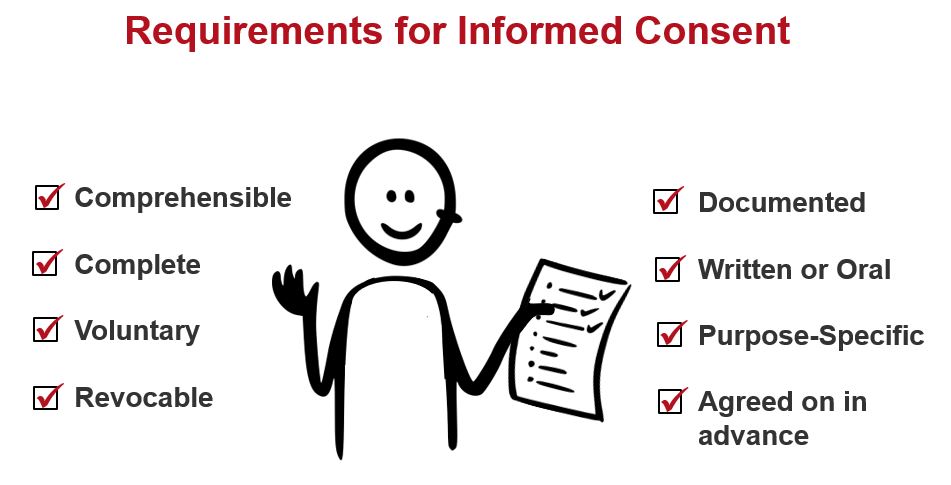Methods: Informed Consent

Source: Informed Consent, Anne Voigt with CoCoMaterial, 2023, licensed under CC BY-SA 4.0
Timing and Form
Consent should ideally be obtained before data collection and should be acquired either in written form, through a signature on a form, or orally, with appropriate documentation.
Although written consent has the advantage of being legally binding and verifiable, it does not necessarily guarantee an ethically appropriate and responsible dissemination of information. It may also be perceived by research participants as too formal or even intimidating, potentially leading to misunderstandings or discomfort. Additionally, obtaining written consent is practically impossible in some cases, such as when research participants are illiterate or when written bureaucratic processes are entirely uncommon in the given research context (see Practical Examples).
If oral consent is coherently and legally documented and verifiable (for example, as a recorded and retrievable confirmation on a recording device), it serves as an effective alternative to written consent. In certain fields and research contexts, it may even facilitate better understanding and establish a stronger trust relationship between researchers and participants:
„Recorded oral consent on audio or even on video tape combined with oral explanations may replace a signed form.“
(Huber & Imeri, 2021, p. 16)
To ensure that an oral consent declaration meets data protection requirements, it is advisable to consult with the data protection officers of the respective institution1The data protection officer of FU Berlin can be found at: https://www.fu-berlin.de/en/einrichtungen/interessenvertretungen/datenschutz/dahlem/index.html.
The form of documentation (whether written or oral) should be adapted to the specific research context and negotiated consensually with the involvement of research participants:
„Every single case needs its own strategy for negotiating consent“.
(Huber & Imeri, 2021, p. 13)
Contents
The following three components should ideally be included in informed consent to ensure its legal and substantive completeness and effectiveness (Verbund FDB, 2019; Imeri et al., 2023, p. 235):
1) Information about the Research Project
- Introduction to the research project – details on content, process, and objectives
- Methods of data collection (e.g., questionnaires, video recording, photography, conducting interviews, participant observation, etc.)
- Names of the participating research institutions
2) Data Protection and Rights
- Information on key rights related to participation, as well as data processing and sharing, particularly regarding voluntariness and the right to withdraw, limit processing, or object without any disadvantages
- Possibility of revocation with effect for the future
- Information on which personal data (e.g., names, address details, age) and, if applicable, special categories of personal data under the GDPR will be collected and processed
- Identity of those responsible and the data processing entities
- Purposes, objectives, and details on the intended processing and use (e.g., dissertation to be published); if archiving and reuse are planned, these should be explicitly mentioned
- Notes on the type of processing, if already known (e.g., transcription, planned anonymization procedures, etc.)
- Reference to the confidential handling of personal data: for example, separate storage of contact and research data
- Information on how research data will be stored, preserved, and used in the long term
3) Consent Form
- Confirmation of consent, name, location/date, signature
Literature
Huber, E. & Imeri, S. (2021). Informed consent in ethnographic research: A common practice facing new challenges (preprint), Qualiservie Working Papers Nr. 4-2021. http://dx.doi.org/10.26092/elib/1070
